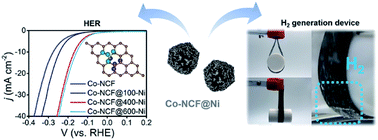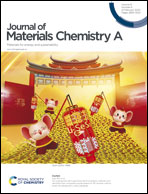Nickel nanograins anchored on a carbon framework for an efficient hydrogen evolution electrocatalyst and a flexible electrode†
Abstract
The atomic layer deposition (ALD) technique has been widely employed in the development of efficient electrochemical hydrogen evolution reaction (HER) catalysts. Nevertheless, most of the studies through this methodology are confined to the use of precious metals or non-precious materials with poor performance, especially in alkaline electrolytes. Herein, we report a novel strategy of fabricating nickel nanograins coated onto a Co, N-doped carbon framework (Co-NCF@Ni) based on the manipulation of ALD and in situ transformation of a cobalt zeolitic imidazolate framework for efficient hydrogen evolution in alkaline media. The catalytic performance of the Co-NCF@Ni with different Ni contents is specifically studied. On the basis of this composite, a flexible high-performance H2 production device, distinguished from the conventional powdery pattern, is realized, and stable performance under a repeated rolling process is demonstrated. In order to disclose the mechanism of the remarkable HER performance, density functional theory calculations are carried out and the results indicate that the electron structures of inner Co atoms, external Ni atoms, and the N-doped carbon layer can be tuned due to the introduction of Ni nanoparticles. The research presented here may have great potential in developing both high efficiency transition-metal based electrocatalysts and flexible H2-production devices for use under extreme conditions.



 Please wait while we load your content...
Please wait while we load your content...